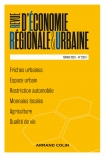
REVUE D'ÉCONOMIE RÉGIONALE ET URBAINE (2/2021)
Pour acheter ce numéro, contactez-nous
Recevez les numéros de l'année en cours et accédez à l'intégralité des articles en ligne.
À l’aide d’une analyse structurale, nous montrons que tout déplacement mobilise un mode fiable, un réseau suffisamment maillé, un utilisateur compétent et un ensemble de règles communes, le tout formant un système modal. Les deux premiers constituants correspondent au système technique de transport. Les deux derniers représentent la dimension humaine et sociale de la mobilité. Chaque constituant de ce système génère un effet particulier : de club, de parc, de réseau ou de sécurité. Pour qu’un système modal se développe, toutes ses composantes doivent progresser de concert, afin d’éviter qu’apparaissent des décalages qui ralentissent le processus. Les progrès s’accélèrent quand une certaine cohérence est trouvée. Tous les aspects de la mobilité peuvent être analysés à travers ce quadriptyque, comme les modèles de trafic en quatre étapes, la sécurité routière, le report modal ou les externalités négatives des transports.
Using a structural analysis, we show that any journey requires a reliable mode, a sufficiently meshed network, a competent user and a common set of rules, all forming a modal system. The first two components correspond to the technical transport system studied by the engineers. The last two represent the human and social dimension of mobility, which is of particular interest to sociologists. Each constituent of this system generates a particular effect: a club effect, a park effect, a network effect or a safety effect. For a modal system develops, all its components must progress together, in order to avoid the emergence of mismatchies that slow down the process. Progress is accelerated when a certain coherence is found. The history of each transport mode can therefore be analysed as a search for a balance between all these components. The competition between modes explains to a large extent how the evolution of a modal system is initiated or halted. All aspects of mobility can be analysed through this quadriptych. For example, the four-stage traffic model cover the four identified components. Road safety mobilises the triptych vehicle-infrastructure-driver, but some specialists deplore the fact that the social dimension is forgotten. A modal shift is only possible if all components of the new modal system are stimulated. The negative externalities of transport converge towards four major indirect impacts: degradation of human health, disaffection for non-motorised modes (i.e. dependence on motorised modes), reduction in neighbourhood relations (and an increase in distant relations) and degradation of the living environment.
